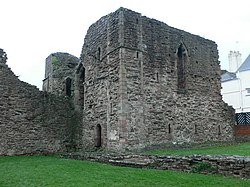Battle of Monmouth (1233)
| Battle of Monmouth | |||||||
|---|---|---|---|---|---|---|---|
| Part of Rebellion by Richard Marshal against Henry III | |||||||
 The ruined Great Tower of Monmouth Castle |
|||||||
|
|||||||
| Belligerents | |||||||
|
English Welsh |
English Fleming |
||||||
| Commanders and leaders | |||||||
| Richard Marshal | Baldwin III, Count of Guînes | ||||||
| Strength | |||||||
| ? | ? | ||||||
| Casualties and losses | |||||||
| Heavy | |||||||
The Battle of Monmouth took place on 25 November 1233, the feast day of St Catherine, between forces loyal to Henry III, King of England, and those of Richard Marshal, Earl of Pembroke and Lord Marshal of England, who had formed an alliance with the Welsh prince Llywelyn ap Iorwerth and his supporter Owain ap Gruffudd, a grandson of Rhys of Deheubarth.
Richard Marshal, the second son of the more famous William Marshal, 1st Earl of Pembroke, was a leader of the barons opposed to the growth of King Henry's powers. He was an adversary of the king's foreign allies at court, notably the Poitevins Peter de Rivaux and Peter des Roches. Marshal refused to attend Henry's court at Gloucester in August 1233, and Henry declared him a traitor. Marshal retired to his castle at Striguil (Chepstow), while the king and his army moved west to Abergavenny. In response, Marshal joined with Owain to seize the castles at Cardiff and Newport before attacking Abergavenny and Grosmont. The king then retreated to Gloucester.
...
Wikipedia
